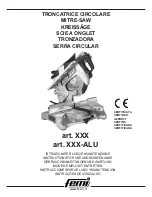
18 ENGLISH
►
Fig.23:
1.
Mounting shaft
2.
Inner flange
3.
Circular
saw blade
4.
Outer flange
5.
Hex bolt
WARNING:
BE SURE TO TIGHTEN THE HEX
BOLT CLOCKWISE SECURELY. Also be careful
not to tighten the bolt forcibly. Slipping your hand
from the hex wrench can cause a personal injury.
WARNING:
Make sure that the protrusion "a"
on the inner flange that is positioned outside fits
into the saw blade hole "a" perfectly.
Mounting the
blade on the wrong side can result in the dangerous
vibration.
For tool with the inner flange for a
15.88 mm hole-diameter saw blade
(country specific)
Mount the inner flange with its recessed side facing
outward onto the mounting shaft and then place circu-
lar saw blade (with the ring attached if needed), outer
flange and hex bolt.
For tool without the ring
►
Fig.24:
1.
Mounting shaft
2.
Inner flange
3.
Circular
saw blade
4.
Outer flange
5.
Hex bolt
For tool with the ring
►
Fig.25:
1.
Mounting shaft
2.
Inner flange
3.
Circular
saw blade
4.
Outer flange
5.
Hex bolt
6.
Ring
WARNING:
BE SURE TO TIGHTEN THE HEX
BOLT CLOCKWISE SECURELY. Also be careful
not to tighten the bolt forcibly. Slipping your hand
from the hex wrench can cause a personal injury.
WARNING:
If the ring is needed to mount the
blade onto the spindle, always be sure that the
correct ring for the blade's arbor hole you intend
to use is installed between the inner and the outer
flanges.
Use of the incorrect arbor hole ring may
result in the improper mounting of the blade causing
blade movement and severe vibration resulting in
possible loss of control during operation and in seri-
ous personal injury.
Blade guard cleaning
When changing the circular saw blade, make sure to
also clean the upper and lower blade guards of accu-
mulated sawdust as discussed in the Maintenance
section. Such efforts do not replace the need to check
lower guard operation before each use.
Connecting a vacuum cleaner
Optional accessory
When you wish to perform clean cutting operation,
connect a Makita vacuum cleaner to your tool. Connect
a hose of the vacuum cleaner to the dust nozzle using
the front cuff 24.
►
Fig.26:
1.
Hose of the vacuum cleaner
2.
Front cuff
24
3.
Dust nozzle
Adjusting angle of dust nozzle
The angle of the dust nozzle can be adjusted by rotating
the dust nozzle.
When operating the tool without connecting a vacuum
cleaner, bring the dust nozzle downward to prevent the
operator from being exposed to sawdust.
When operating the tool with connecting a vacuum cleaner,
bring the dust nozzle upward to keep the hose of the vacuum
cleaner from getting caught in the workpiece or the guide rail.
►
Fig.27:
1.
Dust nozzle
OPERATION
This tool is intended to cut wood products. With appro
-
priate Makita genuine circular saw blades, following
materials can also be sawed:
•
Aluminum products
•
Mineral contained plastic
Refer to our website or contact your local Makita dealer
for the correct circular saw blades to be used for the
material to be cut.
Do not use the tool without the sub base unless when
using the guide rail.
CAUTION:
When cutting plastic materials,
avoid melting it by overheating of the blade tip.
Checking blade guard function
Set the bevel angle to 0°, and then retract the lower
guard manually to the end and release it. The lower
guard is properly functioning if;
— it is retracted above the base without any hin
-
drance and;
— it automatically returns and contacts with the
stopper.
►
Fig.28:
1.
Upper guard
2.
Lower guard
3.
Base
4.
Stopper
5.
Open
6.
Close
If the lower guard is not functioning properly, check if
saw dust is accumulated inside of the upper and lower
guards. If the lower guard is not functioning properly
even after removing dust, have your tool serviced at a
Makita service center.
Cutting operation
CAUTION:
Wear dust mask when performing
cutting operation.
CAUTION:
Be sure to move the tool forward
in a straight line gently.
Forcing or twisting the tool
will result in overheating the motor and dangerous
kickback, possibly causing severe injury.
NOTE:
When the battery cartridge temperature is
low, the tool may not work to its full capacity. At this
time, for example, use the tool for a light-duty cut for
a while until the battery cartridge warms up as high
as room temperature. Then, the tool can work to its
full capacity.
►
Fig.29
Summary of Contents for DHS900
Page 2: ...Fig 1 Fig 2 Fig 3 Fig 4 Fig 5 Fig 6 1 2 3 4 Fig 7 2 ...
Page 3: ...3 1 2 B A Fig 8 1 2 Fig 9 1 2 Fig 10 1 Fig 11 1 Fig 12 1 1 Fig 13 1 Fig 14 1 Fig 15 3 ...
Page 4: ...2 1 Fig 16 1 Fig 17 1 Fig 18 1 1 2 Fig 19 2 1 4 3 Fig 20 1 2 3 4 Fig 21 4 ...
Page 6: ...Fig 29 1 Fig 30 1 1 2 Fig 31 1 1 2 Fig 32 1 Fig 33 1 Fig 34 6 ...
Page 7: ...1 Fig 35 Fig 36 1 Fig 37 1 3 4 2 Fig 38 1 2 3 Fig 39 1 Fig 40 7 ...
Page 8: ...1 2 1 2 Fig 41 Fig 42 1 Fig 43 1 2 Fig 44 1 Fig 45 1 Fig 46 8 ...
Page 9: ...1 2 1 2 Fig 47 1 1 2 Fig 48 1 1 Fig 49 1 2 Fig 50 1 Fig 51 9 ...
Page 10: ...1 1 A B 2 Fig 52 10 ...
Page 165: ...165 ...
Page 166: ...166 ...
Page 167: ...167 ...
















































